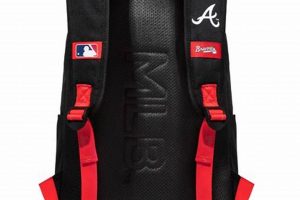A specialized carrying system designed for skiers venturing beyond groomed trails, it facilitates the transportation of essential equipment such as avalanche safety tools (shovel, probe, transceiver), extra layers, food, water, and potentially skis or a snowboard. These packs prioritize safety, functionality, and comfort in demanding environments. An example of its use is a skier preparing for a day in the mountains, loading the carrying system with rescue gear before ascending.
The importance of such a system stems from the inherent risks associated with off-piste skiing. Its benefits include the ability to carry life-saving equipment, enhance preparedness for unexpected weather changes, and improve overall self-sufficiency in remote locations. Historically, skiers would often carry gear haphazardly. However, the development of dedicated carrying systems has significantly increased safety and efficiency in backcountry travel.
The subsequent sections will delve into the specific features of these systems, focusing on aspects such as volume, material construction, avalanche tool organization, carrying systems, and additional components that contribute to its overall utility and effectiveness in the mountains.
Backcountry Ski Backpack
Selecting and utilizing a specialized carrying system requires careful consideration to ensure both safety and efficiency in backcountry environments. The following points provide essential guidance for responsible use.
Tip 1: Volume Selection. Choose a volume appropriate for the planned duration and nature of the trip. Shorter tours may necessitate smaller volumes (20-30 liters), while multi-day excursions require larger capacities (40+ liters) to accommodate additional gear.
Tip 2: Avalanche Tool Organization. Ensure rapid and intuitive access to avalanche safety equipment (shovel, probe, transceiver). Dedicated compartments designed for these tools are crucial for swift deployment in emergency situations.
Tip 3: Fit and Suspension. Prioritize a system with an adjustable torso length and a supportive suspension system. A properly fitted system distributes weight effectively, reducing strain and fatigue during long ascents and descents.
Tip 4: Material Durability. Opt for a system constructed from durable, weather-resistant materials such as high-denier nylon or reinforced fabrics. This ensures the system can withstand the rigors of backcountry use and provide protection against the elements.
Tip 5: Ski/Snowboard Carry System. Familiarize oneself with the chosen ski or snowboard carry system (A-frame, diagonal, vertical) and practice its operation before venturing into the backcountry. Secure attachment is essential to prevent equipment loss or injury.
Tip 6: Hydration Compatibility. A hydration-compatible system facilitates convenient access to water, reducing the need to stop and retrieve water bottles from within the pack. This is critical for maintaining hydration levels and preventing dehydration during strenuous activity.
Tip 7: Weight Management. Pack the system strategically, placing heavier items closer to the center of gravity to improve balance and stability. Minimize unnecessary weight by selecting lightweight gear and avoiding overpacking.
Adhering to these recommendations optimizes the functionality of the carrying system, contributing significantly to a safer and more enjoyable backcountry experience.
The following sections will elaborate on specific features and considerations for advanced backcountry travel, including crevasse rescue gear and overnight camping equipment.
1. Volume and weight distribution
Volume and weight distribution are inextricably linked in the context of carrying systems designed for backcountry skiing. Volume, measured in liters, dictates the overall capacity of the system, directly influencing the amount of gear a skier can carry. Incorrect weight distribution within that volume can lead to instability, increased fatigue, and compromised safety. The relationship is causal: increased volume necessitates more careful consideration of weight distribution. For instance, a large volume packed unevenly can create a pendulum effect during skiing, increasing the risk of falls. Proper weight distribution, conversely, enhances balance, reduces strain on the musculoskeletal system, and improves overall efficiency. The importance of balanced loading becomes exponentially greater in challenging terrain.
Specific examples underscore the practical significance of this understanding. Packing heavy items, such as water reservoirs or spare layers, low and close to the skier’s center of gravity improves stability on steep slopes. Conversely, placing bulky, lightweight items near the top can raise the center of gravity, increasing the likelihood of losing balance during turns or navigating uneven terrain. Furthermore, proper weight distribution ensures that the harness system of the pack functions as intended, distributing the load effectively across the hips and shoulders, rather than concentrating it on one area. Ill-distributed weight can lead to chafing, pressure points, and ultimately, impaired performance and potentially injury.
In summary, the effective management of volume and weight distribution within a system designed for backcountry skiing is paramount for safety, comfort, and performance. Understanding the principles of balanced loading and the consequences of improper distribution allows skiers to optimize their carrying system for the specific demands of the backcountry environment. Challenges remain in consistently achieving optimal distribution in dynamic conditions, but continuous refinement of packing techniques and equipment selection is crucial for mitigating risks.
2. Avalanche tool accessibility
Avalanche tool accessibility is a fundamental design and usability consideration for any carrying system intended for backcountry ski travel. The rapid and unhindered retrieval of these toolsshovel, probe, and transceiveris paramount in the event of an avalanche burial, directly impacting the victim’s chances of survival. Therefore, the carrying system must prioritize ease of access without compromising security or overall pack functionality.
- Dedicated Compartments
Dedicated compartments within the carrying system, specifically designed for avalanche tools, are crucial. These compartments separate the tools from other gear, preventing entanglement and ensuring immediate access. Real-world scenarios often involve urgency and stress; a cluttered pack can significantly delay the rescue process. The design should allow for gloved operation and intuitive identification of each tool’s location.
- Rapid Deployment Systems
The integration of rapid deployment systems further enhances accessibility. These systems may include quick-release buckles, zippers, or specialized sleeves that allow for immediate removal of the shovel and probe without fully opening the pack. Time saved during deployment can be critical in locating and extricating a buried victim. The effectiveness of these systems relies on regular practice and familiarity by the user.
- Transceiver Pocket Placement
The placement of the transceiver pocket is equally vital. It should be located in a readily accessible area, typically on the shoulder strap or hip belt, allowing the user to quickly check the transceiver’s status and signal strength without removing the pack. The pocket must be secure to prevent accidental dislodgement but easily opened in an emergency. Proximity to other electronic devices should be avoided to minimize potential interference.
- Glove-Friendly Operation
All access points and release mechanisms associated with avalanche tools must be designed for glove-friendly operation. Small buckles, tight zippers, or intricate closures can be difficult or impossible to manipulate while wearing gloves, adding precious seconds to the rescue effort. Oversized zippers, reinforced pull tabs, and intuitive designs are essential for efficient use in cold weather conditions.
In conclusion, avalanche tool accessibility is not merely a feature of a carrying system; it is a critical safety component that demands careful consideration in both design and user practice. The integration of dedicated compartments, rapid deployment systems, strategic transceiver pocket placement, and glove-friendly operation collectively contributes to a system that maximizes the potential for a successful avalanche rescue. Frequent practice with these features is vital for proficiency in emergency situations.
3. Carry system compatibility
The compatibility of a backcountry ski backpack’s carrying system with skis or a snowboard is a critical determinant of its overall utility and safety. Incompatibility necessitates makeshift solutions, compromising stability, increasing fatigue, and potentially leading to equipment damage or personal injury. The design of the carrying system must align precisely with the dimensions and characteristics of the skis or snowboard being transported. A mismatch between the pack’s attachment points and the equipment’s geometry introduces instability, making ascents and descents more arduous and increasing the risk of falls.
Real-world examples illustrate the practical significance of this compatibility. A-frame systems, where skis are attached to either side of the pack, require secure bindings and adjustable straps to accommodate varying ski widths and tail designs. Diagonal carry systems demand sufficient clearance to prevent skis from interfering with the user’s legs during movement. Vertical carry systems, often favored for snowboards, must adequately distribute the weight of the board to prevent the pack from becoming excessively top-heavy. In each case, a failure to ensure proper fit and secure attachment can result in equipment shifting, dislodging, or creating hazardous imbalances. Manufacturers address this through adjustable straps, reinforced attachment points, and clear guidelines on compatible ski or snowboard types. Ignoring these guidelines can negate the safety benefits of the pack itself.
Ultimately, carry system compatibility is not merely a feature but an integral component of a backcountry ski backpack’s design. It directly influences the user’s comfort, efficiency, and, most importantly, safety. Challenges remain in creating systems that accommodate the wide variety of ski and snowboard designs available. However, thorough research, careful selection, and a commitment to understanding the specific requirements of the equipment being carried are essential for maximizing the effectiveness of the carrying system and mitigating risks in the backcountry.
4. Material Durability
Material durability is a paramount consideration in the design and selection of carrying systems intended for backcountry skiing. The demanding nature of the environment necessitates materials capable of withstanding abrasion, tearing, extreme temperatures, and prolonged exposure to moisture. The integrity of the materials directly impacts the pack’s ability to protect essential gear and support the user in potentially hazardous situations.
- Abrasion Resistance
Abrasion resistance is critical due to frequent contact with rocks, trees, and snow surfaces. High-denier nylon or polyester fabrics, often with reinforced coatings, are commonly employed to mitigate wear and tear. For example, a pack constructed from a lower-denier fabric may quickly develop holes or tears when subjected to repetitive friction against sharp rocks, compromising its structural integrity and the safety of the contents.
- Tear Strength
Tear strength is essential to prevent catastrophic failure of the pack in the event of a snag or puncture. Fabrics with ripstop weaves, which incorporate a grid-like pattern of stronger threads, are often used to contain tears and prevent them from spreading. An example of its importance is when a ski edge catches on the pack fabric, the ripstop weave prevents the tear from expanding and rendering the pack unusable.
- Water Resistance and Waterproofing
Water resistance, achieved through coatings or laminated membranes, protects the contents from snow, rain, and meltwater. While fully waterproof fabrics may be used in some areas, breathability is also a concern to prevent internal condensation. A pack with poor water resistance can lead to wet gear, increasing weight, reducing thermal insulation, and potentially leading to hypothermia. Some carrying systems include a rain cover stored in a dedicated pocket.
- Temperature Resistance
Temperature resistance ensures that the materials retain their flexibility and strength in extreme cold. Some materials become brittle and prone to cracking at low temperatures, compromising the pack’s structural integrity. For instance, plastic buckles or webbing made from low-quality materials may shatter in sub-zero conditions, rendering the pack unusable. Manufacturers often specify the operating temperature range of their products to guide users in selecting appropriate gear for their intended environment.
The interplay of these material properties dictates the overall durability and reliability of a carrying system. A system constructed from materials lacking in one or more of these areas is likely to fail prematurely, potentially jeopardizing the safety and well-being of the user in the backcountry. Therefore, careful consideration of material specifications is essential when selecting a carrying system for backcountry skiing.
5. Fit and Adjustability
Fit and adjustability are not merely desirable features of a backcountry ski backpack; they are fundamental prerequisites for safe and efficient operation. The correlation between a properly fitted and adjusted system and a skier’s performance and safety is direct. An ill-fitting system compromises balance, restricts movement, and increases the risk of injury, while a well-adjusted system distributes weight effectively, enhances stability, and allows for a full range of motion. For example, a pack with a torso length that is too long will shift the load downwards, pulling on the skier’s shoulders and creating excessive pressure on the lower back, resulting in fatigue and potential back strain.
Adjustability allows for customization to accommodate individual body shapes, clothing layers, and load variations. Key adjustment points include torso length, shoulder strap curvature, hip belt angle, and sternum strap position. These adjustments enable the skier to fine-tune the fit, ensuring that the pack conforms to their body and moves with them, rather than against them. Consider a scenario where a skier encounters varying terrain; an adjustable system allows for on-the-fly modifications to maintain optimal balance and comfort. Similarly, adding or removing layers of clothing necessitates adjustments to the shoulder straps and hip belt to maintain a secure and comfortable fit throughout the day. A critical feature is the ability to adjust the carrying system while wearing gloves in harsh weather conditions.
In summary, proper fit and adjustability are non-negotiable attributes of a backcountry ski backpack. The ability to customize the fit to match individual anatomy and adapt to changing conditions directly impacts the skier’s safety, comfort, and overall performance. While advanced materials and design features contribute to the pack’s functionality, a poor fit negates these benefits. A commitment to proper fitting and adjustment practices is essential for mitigating risks and maximizing the utility of the carrying system in the challenging backcountry environment. A correctly adjusted system becomes an extension of the skier’s body, enhancing performance and increasing confidence.
Frequently Asked Questions
This section addresses common inquiries and misconceptions regarding carrying systems designed for backcountry skiing. The information provided is intended to enhance understanding and promote responsible decision-making.
Question 1: What distinguishes a system from a standard hiking system?
Systems are specifically engineered to accommodate the unique demands of backcountry skiing, including dedicated compartments for avalanche safety equipment, secure ski/snowboard carry systems, and durable materials designed to withstand harsh conditions. Standard hiking systems typically lack these features, rendering them less suitable for the specific risks and requirements of backcountry travel.
Question 2: How crucial is volume selection in a carrying system?
Volume is a critical factor, directly influencing the amount of gear that can be carried. Smaller volumes (20-30 liters) are suitable for shorter tours, while multi-day excursions require larger volumes (40+ liters) to accommodate essential equipment such as extra clothing, food, and shelter. Insufficient volume can compromise safety by limiting the ability to carry necessary supplies.
Question 3: Why is avalanche tool accessibility emphasized so heavily?
Rapid access to avalanche safety tools (shovel, probe, transceiver) is paramount in the event of a burial. Every second counts, and dedicated compartments and rapid deployment systems can significantly reduce the time required to locate and extricate a victim. Delayed access to these tools can drastically reduce the chances of survival.
Question 4: How does carrying system fit impact safety and performance?
A properly fitted system distributes weight effectively, enhancing balance and reducing strain on the musculoskeletal system. An ill-fitting system can compromise stability, restrict movement, and increase the risk of injury. Adjustability is crucial for accommodating individual body shapes and varying clothing layers.
Question 5: What materials are most suitable for a carrying system used in backcountry skiing?
Durability is essential. High-denier nylon or polyester fabrics with reinforced coatings provide abrasion resistance, tear strength, and water resistance. Materials must also retain their flexibility and strength in extreme cold. Low-quality materials can fail prematurely, jeopardizing the safety of the user and the contents of the system.
Question 6: Are there specific certifications or standards to look for when purchasing a carrying system?
While there are no universal certifications specific to carrying systems for backcountry skiing, reputable manufacturers often adhere to rigorous quality control standards and conduct extensive testing to ensure their products meet or exceed industry expectations. Researching manufacturer reputation and reading product reviews can provide valuable insights into product performance and reliability.
In summary, the selection and proper use of a carrying system significantly impact safety and performance in the backcountry. Understanding the factors discussed in this section is crucial for making informed decisions and mitigating the risks associated with backcountry travel.
The subsequent section will explore advanced topics such as crevasse rescue gear and considerations for overnight expeditions.
Conclusion
This exploration has highlighted the critical role of a backcountry ski backpack in facilitating safe and efficient travel in ungroomed terrain. Considerations of volume, avalanche tool accessibility, carry system compatibility, material durability, and proper fit are not merely design features, but rather essential elements that directly impact user safety and performance. A comprehensive understanding of these components is imperative for informed decision-making.
Proficient utilization of such a carrying system represents a cornerstone of responsible backcountry practice. Vigilance in equipment selection, coupled with continuous refinement of packing and usage techniques, remains crucial. Prioritizing safety through preparation and knowledge empowers individuals to navigate the backcountry with increased confidence and reduced risk.







![Best High Sierra Loop Daypack Backpack [Guide] Ultimate Backpack Traveler Guide: Tips, Destinations & Budget Hacks Best High Sierra Loop Daypack Backpack [Guide] | Ultimate Backpack Traveler Guide: Tips, Destinations & Budget Hacks](https://backpack-traveler.com/wp-content/uploads/2025/11/th-871-300x200.jpg)